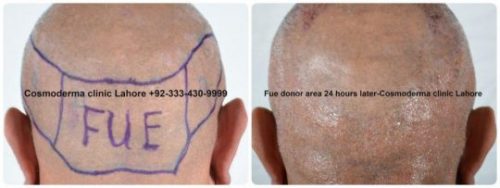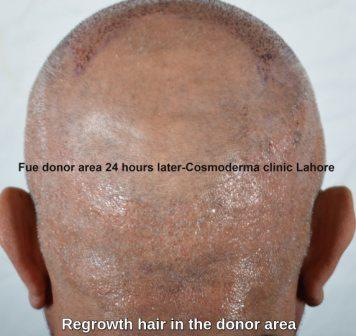Follicular hair transplant is a procedure for increasing the growth of hairs on an area of the scalp which has been showing slow growth, thinning or pattern baldness. This procedure is preferred by many people who are planning to get a hair restoration surgery. Due to increased preferences and the skilled professional, this procedure has gained enough popularity and is practiced in the majority of the countries. This process is initiated by applying topical analgesia in the scalp. The area which is rich in hair growth is usually used as a donor and hair follicles are taken from this area. This process is called extraction. These grafts are then kept under an appropriate environment until whole extraction in the donor area is performed. The area showing less hair growth or bald patches is called the recipient area. The hair follicles are inserted in this area. The patient is allowed to take a few precautionary measures for 2 to 3 weeks after which he can carry out his normal chores. Post-surgical medications are also prescribed and the patients recover in a couple of weeks. The recipient’s area shows an increase in hair volume in 2 to 3 months.
Does the donor area grow back after hair transplant?
Many people who have undergone hair restoration procedures asked this question. The growing of hairs at the recipient’s area is the final result of the procedure, however, what will happen if the donor area becomes bald and hairs do not grow back in this area? After the removal of hairs from the donor area, it becomes red and swollen. Sometimes it might bleed as the extraction is carried out by the use of a needle like device. The pain sensation can be felt after the duration of action of applied topical analgesia has stopped but it is the mild discomfort or pain and it can be treated by taking paracetamol. The redness and swelling also fades away in a day or so, following hair transplant. The bleeding follicles are converted to black crusts and they fall in 15 days. After this the hair follicles grow back new hairs and this is a trusted fact. The hair follicles grow back the new hairs however the time duration may vary in different individuals. The growth period of hairs back in the donor area depends upon the healthy environment provided to the scalp and the work of the surgeon on how well he has performed his job.
Donor hair follicles
Hair follicles are the hair growth supporting structures and these are extracted along with the hair shaft in hair transplant procedures. Usually a graft is extracted in a hair restoration process which consists of a hair follicles group containing one or many hairs. These are taken from the donor area which is usually at the back of the head, however if a person lacks enough hairs on the scalp, other areas of the body which are rich in hair growth can also serve as donor areas: chest, beard, arm pits or thighs can serve the purpose if rich in hair growth. Before a procedure, the donor area is shaved such that hair follicles remain intact. They are then extracted and moved to the recipient’s area. Special care should be given to the donor area in order to decrease the duration for the healing process. It should be kept clean and dry to prevent the risk of infection and maintain a healthy environment for scalp so that hair grows back healthy. It is better to avoid sun exposure for the time period until the donor area is healed. It is also advised to avoid the use of caps and prevent moisture build up due to sweating as it increases the chances of infection.
How many grafts can be extracted from the donor area?
In a hair transplant, follicles containing one or more hairs are extracted out. The number of grafts that are needed to be transplanted depends upon the size of the recipient’s area. The follicle containing one strand is placed in the hairline and the follicles containing two or more hairs are placed in the back of head or bald spots. Such a donor area is chosen which can donate at least 3000 to 5000 grafts. A healthy donor area contains about 20,000 follicles which are supported on 4500 grafts approximately. During a transplant, if a greater number of grafts are transplanted from the donor area, it will cause the thinning of the donor area. If more numbers of grafts are needed, one can look up to other options such as attending hair restoration surgery in more than one session. The time period of two consecutive sessions could be such that the donor area gets enough time to regrow the lost hair follicles. If rapid results are needed, a surgeon can use other than one donor area from different hair growing sites on the body.
Please also see :- hair transplant before and after results by Dr Ahmad Chaudhry
How to improve hair donor area?
Hair growth in the donor area following a hair transplant can be improved by following simple tips. It is feasible to shave the donor area after the scabs have disappeared which usually occurs in a week. It is better to use panama type loose cloths to cover the donor area instead of tight fitting caps. Sweating can initiate bacterial growth in wounded areas so it is advised to avoid exercises that bring out sweat. Alcohol consumption is found to increase the healing time so it should be avoided. Sun exposure should be minimized for at least 2 weeks. Soothing lotions are available at various hair clinics that are given to patients to reduce any unpleasant sensation. They should be applied gently. In order to reduce scarring, ointments and creams could be prescribed. Patients are also prescribed by some antibiotics prophylactically to reduce the risk of developing infection. DHT blocker or minoxidil is prescribed to increase the rate of hair growth. The patients are advised to take biotin supplements to aid in faster and healthier growing hairs. Taking a diet rich in proteins can also increase the hair growth process. Eating green vegetables, fish egg and foods which are a good source of zinc, vitamins and iron can fasten healthy hair growth.



